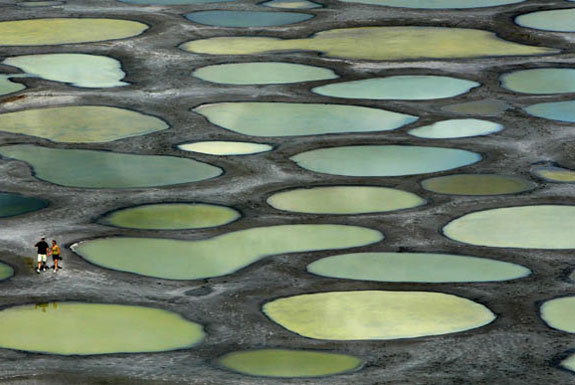It is most impressive at night and the glow from its flames can be seen miles away. The inside of the crater is black from carbon build up and the heat is so intense that it is only possible to stay near the edge for a few minutes. In 1971, a team of Soviet prospectors allegedly drilled into a large chamber filled with natural gas. The roof of the cavern collapsed leaving a crater-like sinkhole some 25 metres deep with a diameter of approximately 60 - 70 metres. It soon became evident that natural gas was still rising into the crater from even deeper sources and the story goes that the decision was made to ignite the emissions rather than risk either a concentrated build-up of gas or local poisoning. According to various sources it has burned continuously since then and has apparently been named “The Gate to Hell” by the local people.

2. 9 HELLS OF BEPPU - JAPAN
Beppu, located on the Japanese island of Kyūshū, is the second largest producer of geothermal water in the world. Located in the same area are the “Nine Hells” or ponds that each has its own remarkable character and colour thanks to the variety of minerals in the outflows.

3. TRAVERTINE POOLS OF PAMUKKALE - TURKEY
Thousands of years ago earthquakes, which are common in Turkey, created fractures that allowed powerful hot springs to bring water rich in calcium carbonate to the surface. As the water evaporated the chalky material condensed and formed layer-upon-layer of Travertine and thus slowly built up the walls over time in the same way that a stalactite forms in a cave.

4. GREAT BLUE HOLE OF BELIZE- BAHAMAS
The Great Blue Hole is located in the Light House Reef aproximately halfway between Long Caye and Sandbore Caye. It is about 60 miles east from the mainland of Belize (city). In 1997 it was designated as a World Heritage site. Divers have reported a vast number of aquatic creatures some of which are still new to science. In addition, they’ve recorded chambers filled with stalactites and stalagmites which only form in dry caves. For the explorers this was proof that at one time, nearly 65,000 years ago, when the world was in the grip of the last major ice age, the sea level of the Bahamas was up to 150 metres lower than it is today. Over time the limestone of the islands was eroded by water and vast cave networks created. When sea levels rose again about 10,000 years ago some of these collapsed inwards and the Blue Holes were formed.

5. EYE OF AFRICA-MAURITANIA
From space this mysterious depression in the Sahara Desert of Mauritania really does look like a human eye. This natural phenomenon is actually a richat structure caused by the dome shaped symmetrical uplifting of underlying geology now made visible by millennia of erosion. Please note that this explanation is not wholly accepted by the scientific community. There still remain academics that believe it is the sight of a meteor impact and yet others still that believe it resembles the formations caused by underground nuclear blasts

6. SAILING STONES OF RACETRACK PLAYA -USA
The Sailing Stones add mystique to Death Valley but the real strangeness of this place is its desperate isolation, heat and incredible flatness.Once a year the "Playa" or flat desert pan experiences short winter rains and becomes slippery as the hexagonal desert floor turns back to mud. During this time the boulders and rocks move leaving clearly visible tracks behind them. Although scientists believe that high winds are responsible, some of the rocks will suddenly change directions and move at almost perfect right angles to their previous direction.

7. AURORA BOREALIS -NORTH POLE
Auroras sometimes called the northern and southern (polar) lights or aurorae are natural beautiful light displays in the sky, usually observed at night, particularly in the polar regions. They typically occur in the ionosphere. The Cree people call this phenomenon the “Dance of the Spirits.

8. SPOTTED LAKE - BRITISH COLUMBIA
Spotted Lake is a saline endorheic alkali lake located northwest of Osoyoos in British Columbia. In the summer, most of the water in the lake evaporates leaving behind all the minerals. Large “spots” on the lake appear and depending on the mineral composition at the time, the spots will be different colors. The spots are made mainly of magnesium sulfate, which crystallizes in the summer. Since in the summer, only the minerals in the lake remain, they harden to form natural “walkways” around and between the spots.

9. KAUAI - HAWAII
Kauaʻi is the oldest of the main Hawaiian Islands, it is the fourth largest of the main islands. Seaside lava ledges make for otherworldly experiences on this often-overlooked Hawaiian island.

10. MINE OF RIO TINTO - SPAIN
The vast mines of Rio Tinto give a hypnagogic, almost martian landscape. Its growth has consumed not only mountains and valleys but even entire villages. This river has gained recent scientific interest due to the presence of extremophile aerobic bacteria that dwell in the water.The extreme conditions in the river are analogous to other locations in the solar system thought to contain liquid water, such as subterranean Mars. Río Tinto is notable for being very acidic (pH 2) and its deep reddish hue. It is metal solvent and surely not human-friendly!

No comments:
Post a Comment